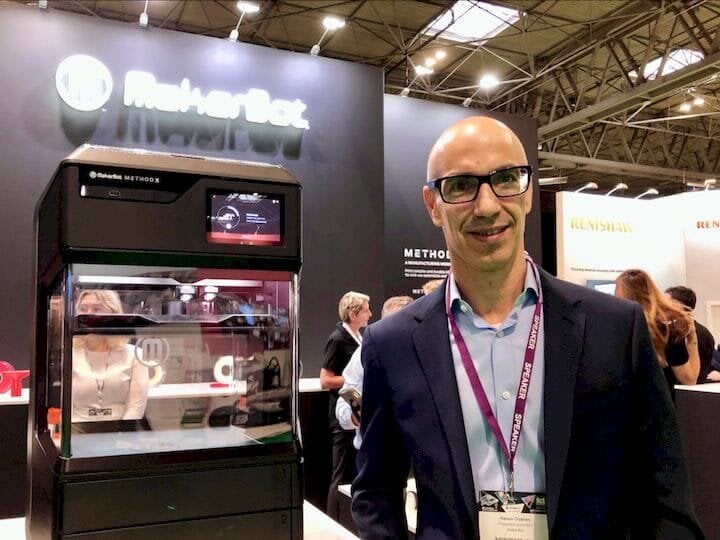![MakerBot CEO Nadav Goshen with the new MakerBot Method X [Source: Fabbaloo]](https://fabbaloo.com/wp-content/uploads/2020/05/nadav-method-x-1_img_5eb08feea697f.jpg) MakerBot CEO Nadav Goshen with the new MakerBot Method X [Source: Fabbaloo]
MakerBot CEO Nadav Goshen with the new MakerBot Method X [Source: Fabbaloo]
Some weeks ago MakerBot announced the Method X, a sequel their earlier machine, the Method.
MakerBot Method
The Method was a very different machine from MakerBot’s earlier devices, having a fully heated enclosure. This is quite unlike machines with heated build plates that accumulate heat by simply surrounding the print bed; the Method actually heated the air inside the chamber and did not even have a heated bed.
There was no need to do so because the entire print, not just the bottom, was consistently heated to exactly the same temperature — up to 55C. This enabled vastly better print quality, when combined with a plethora of sensors and sophisticated control software.
The result was extremely good prints.
MakerBot Method X
The Method X takes those concepts much further.
Like its sibling, the Method X has a heated chamber, but it can reach a sizzling 100C. The reason for this high temperature is for ABS prints, which require a much higher temperature to avoid warping.
Warping will slightly (or greatly) modify the dimensions of the part, and this is entirely inappropriate for many printed parts that must meet precision thresholds.
I was curious about how well ABS does in fact 3D print on this device, and at TCT Show I managed to find out more about the Method X courtesy of CEO Nadav Goshen, who walked me through the machine in detail. I learned quite a few things about the device I had not previously understood.
Method X Features
![Dual nozzles on the MakerBot Method X [Source: Fabbaloo]](https://fabbaloo.com/wp-content/uploads/2020/05/nadav-method-x-hotends-1_img_5eb08feee9892.jpg)
Here we see the Method X’s dual hot ends. This dual extrusion arrangement allows the machine to print highly complex 3D models when using soluble support material.
MakerBot now supports two such materials, the more common PVA, and mother company Stratasys’ SR-30 material, used in their production 3D printers.
![The MakerBot Method X’s filament spools are hidden underneath [Source: Fabbaloo]](https://fabbaloo.com/wp-content/uploads/2020/05/nadav-method-x-spool-1_img_5eb08fef400a7.jpg)
The material spools for the Method X are hidden neatly underneath the build chamber. Goshen explained that this zone includes desiccants that absorb stray moisture to keep the spools dry. It’s also verified by a humidity sensor.
The twenty-some sensors are quite visible on the Method X’s broad control panel. It’s possible to scroll through them — but it takes three pages to do so. But seeing them does not really help the print, as a typical human can’t really interpret them. But that’s where MakerBot’s software takes over. These are all very carefully monitored in real time during printing and adjustments are made to keep them in line with targets.
This sounds good, but does it really work?
MakerBot Method X Print Quality
Here we see a large ABS print.
![A no-warp ABS 3D print in fine detail by the MakerBot Method X [Source: Fabbaloo]](https://fabbaloo.com/wp-content/uploads/2020/05/nadav-method-x-abs-no-warp-1_img_5eb08fef7ac71.jpg)
It’s literally flawless. The print is completely straight without any wobbles or warping. It’s perfectly flat too, as it slaps down on the table without tilting in any direction.
Here’s another sample, which is a strong ABS case for an electronics product. Goshen explained they are using the same formulation for ABS as is used in injection molding, and it’s not cooked in any way for specialized 3D printing.
![Quality ABS 3D prints from the MakerBot Method X [Source: Fabbaloo]](https://fabbaloo.com/wp-content/uploads/2020/05/nadav-method-x-abs-case-print-1_img_5eb08fefbfaf6.jpg)
These look pretty good, but let’s look a bit closer to the print to see it in detail.
![Extreme detail on an ABS 3D print made on the MakerBot Method X [Source: Fabbaloo]](https://fabbaloo.com/wp-content/uploads/2020/05/nadav-method-x-abs-detail-1_img_5eb08ff00aae9.jpg)
Have you ever seen such a fine ABS print? This is beyond good. It almost seems like the extrusion line was square, not round.
Next, another example, an end-effector for a CNC machine.
![A robotic end-effector 3D printed in ABS on the MakerBot Method X [Source: Fabbaloo]](https://fabbaloo.com/wp-content/uploads/2020/05/nadav-method-x-abs-end-effector-1_img_5eb08ff0445af.jpg)
There is an interesting story behind this application. Apparently MakerBot’s customer in this case operates a 5-axis CNC machine in a workshop. In the course of duty, this client must make various kinds of custom end-effectors (the bit that fits on the end of the robot arm and holds, squirts, wipes, touches or whatever it’s supposed to do). This particular end-effector apparently applied glue to something and used compressed air while doing so.
Evidently due to the varying types of work, the client 3D prints custom end-effectors like this one frequently. These are made in strong ABS to withstand the stresses undergone by the CNC machine. The customer told MakerBot:
“I can’t run the US$1M CNC machine without also having the US$6K machine beside it.”
One enables the other.
MakerBot Method X Quality Control
How did MakerBot achieve this level of print quality? Goshen explained to me that they performed a considerable amount of machine testing and tuning. How much? Over 200,000 hours, and that’s a lot! Goshen jokingly added:
“I lost a lot of hair.”
And that seems to be quite true, based on his image above.
If that wasn’t enough, MakerBot has also announced a new ASA material. It’s much like a “Super ABS”, as it has all the properties of ABS but adds chemical and UV light resistance. This makes it very appropriate for 3D printing objects intended for use outside. This material likely 3D prints with similar quality on the Method X.
It seems that MakerBot is quite serious about achieving very high quality prints through the use of precision tuning and controlling the print environment via sensors.
For those who require such high-quality prints, you should definitely take a very close look at MakerBot’s new Method X professional 3D printer.
Via MakerBot

